These days, everyone is looking for a way to make money online. From freelancing work to creating videos to surveys, there are quite a few ways to do so. But what about starting a blog?
Getting into blogging might seem easy, but there’s quite a bit more to it than you may expect. Many a successful blogger won’t see a cent from their work, but most people don’t do the research and take the difficult steps necessary to monetize their blog and generate a profit.

If you’re here, you’re already on the right track. I make six figures in passive income from this blog, and it wasn’t even started to make money – it was started to get clients. Now, I earn money through sponsors and advertisements, in addition to affiliate marketing. It has taken years to establish a solid blog readership to get this far, though.
Even so, there’s no get-rich-quick scheme for blogging and no guarantee, just a lot of research, work, and marketing to tip the scales in your favor.
First, let’s define what a blog is and then jump straight into the 9 essential steps you need to follow to learn how to start a blog efficiently and effectively in our ultimate guide.
What is a Blog? A Quick Definition
A blog is a website or a part of a website that contains frequently updated dynamic content. Most often the content is shown in reverse chronological order, with the most recent new blog post at the top.
Blogs were originally a place for people to jot down their ideas in an online diary, hence the contraction of “web log” into “blog.” However, they now largely serve as a way to keep a website updated and filled with fresh content on a regular basis.
You’ll now find blogs covering every subject imaginable and structured in just as many ways. Plus, one of the many benefits of blogging is the search engine optimization (SEO) aspect: consistently refreshed content means constant search engine attention.
How to Start a Successful Blog in 9 Key Steps
Kickstarting your own blog is far easier and cheaper these days than it used to be, thanks in part to platforms like WordPress and its many competitors revolutionizing the process.
But it’s no simple task. There’s a lot you need to think about before jumping in, and much of it is brainstorming: What will you be blogging about? What will you name it? What’s your content strategy? How will you build an online community?
We’ll cover every nook and cranny, from basic planning to designing the actual website, so you don’t miss a single step of the process.
1. Conduct Research Into a Blog Niche

When you’re starting up your own blog, you can probably guess the first critical steps you need to take – choosing your niche. What will the blog be about? What are your blogging goals?
You probably already have a few business ideas, but research is key at this point. Not all blogging topics will make you money. Some industries are so saturated with how-to articles and listicles that breaking in without a totally unique premise would be all but impossible. Likewise, not every blog topic has enough monthly searches or traffic from search engines to work on a viably profitable blog.
But with the right topic, tone, and premise, you can hook readers and get them coming back for more.

- Write out an initial list of themes, topics, and content ideas that you’re interested in writing blog posts about. Look at your own personal experiences and expertise, as it’s easier to write about something you know well.
- Conduct market research to gauge what topics people want to know more about and what’s likely to generate revenue. It helps to write about what you’re familiar with, but you also need to target what people want to hear.
- Use social listening to track how people are talking about certain topics and trends online.
- Decide what makes your personal blog stand out. Is it your industry experience, your tone and writing style, or the topic itself? What will make the reader value your input and continue coming back?
Once you’ve narrowed down your blog theme to something you’re comfortable writing about and people want to read about, brainstorm a few dozen potential blog post ideas.
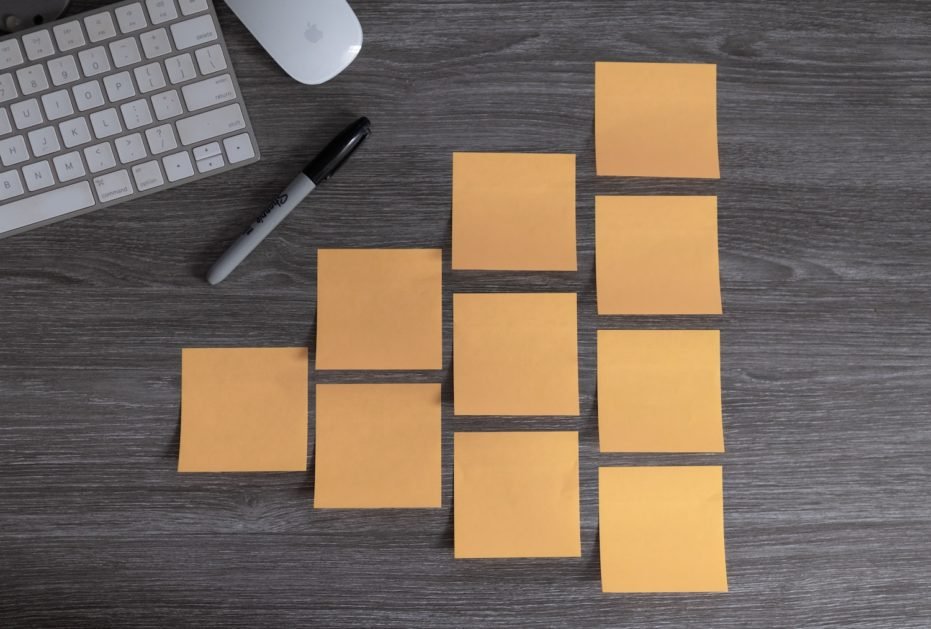
Your blogging niche should be something you’ll be able to write about for years to come, so if you struggle to come up with topics, you may need to target a different niche.
2. Determine Your Primary Monetization Method

Having a solid idea of your blog’s theme may be your primary concern, but if you want to make money, you should start thinking very early about exactly how you’re going to do so. This is what separates your blogging activities from those of non-pro bloggers. You need something with plenty of monetization features if you want to be successful.
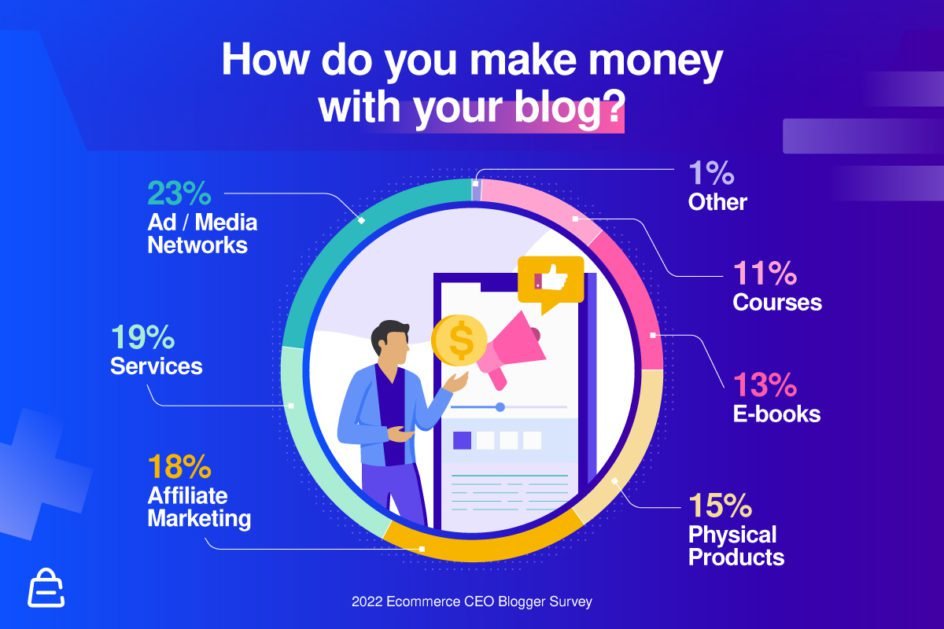
In our survey of professional bloggers, 58% of respondents indicated that they used advertising/media networks to generate revenue. The next two most common answers were selling services and affiliate marketing.
There are several different options available, but here are a few of the most common and successful business models.
Dropshipping
Want to monetize your blog without necessarily jumping through the hoops of starting an entire online store? Dropshipping is the efficient solution.

Dropshipping is when you sell products through a third-party supplier, rather than purchasing inventory and shipping it yourself. It requires far less of an investment while still allowing you to sell products through your blog.
For instance, you could learn how to start a blog about carpentry and direct visitors to a store filled with materials, tools, and kits.
You will still need to deal with taking payments, finding a reliable supplier, and customer service, but it’s a much more accessible way to break into ecommerce.
Print On Demand
If you’re looking to sell small numbers of physical products, the print on demand model may be for you. Instead of purchasing inventory, you work with your supplier to fulfill an order after the purchase is made.

Generally, this involves finding a POD supplier of white label products, which you then apply your own designs onto. Customers could request customized items or logos, which you can then send off to be made by the supplier, or you could test out a small batch of products before committing to a full inventory.
This is very similar to the dropshipping model, but more focused on customization and selling smaller numbers of individual products.
Affiliate Marketing
Affiliate marketing is a very popular monetization method. While it also involves using your blog to sell products, you don’t need to deal with suppliers or payments at all.

Instead, all you need to do is promote and link to affiliate products while blogging. You get a commission on every sale, and your affiliate partners deal with all the shipping and payments.
You won’t make quite as much money, and it can take quite a few clicks before you begin seeing significant returns. But it’s way more hands-off and requires no time or money investment at all.
Getting started involves finding affiliate partners through an affiliate marketing program. One popular choice is Amazon Associates; you’ve likely clicked on an Amazon affiliate link before. You could also sell info products (such as online courses), software, or tech.

Many companies offer an affiliate program, so look into some of your favorite services.
Digital Products
If you’re willing to put in a little extra work, selling digital products can be a great solution for bloggers. These products can include courses, ebooks, downloads, or digital starter kits. This exclusive content can help even a beginner blogger establish a solid connection to their target audience with regular growth in monthly readers. The key is to pay attention to how your blog audience responds, and add more products they want.

One example comes from How to Cake It, which offers an ebook you can purchase:
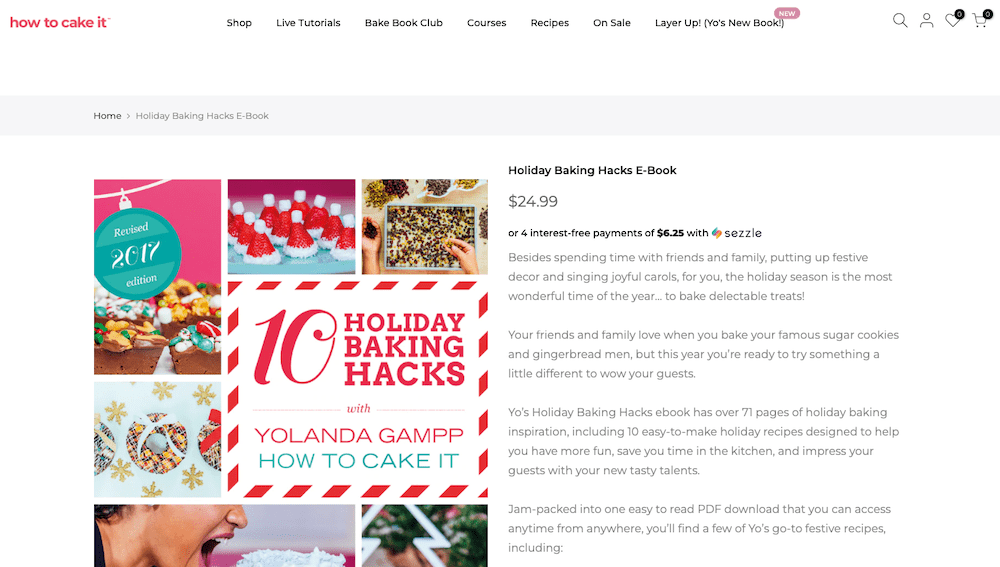
While creating these is a little more involved than blogging, writing and editing is often the bulk of the work you need to do. And it’s very marketable, since readers who love your blog may very well be willing to pay to see more of the same.
Courses
Courses are another type of digital product you can use to monetize your blog. Many blogs these days are full of tutorials and helpful how-to articles, or even centered around creating them. Why not go a step further and create a full-fledged digital course?
If you’re highly knowledgeable in a subject and can put together an in-depth, step by step guide on the right topic, you stand to make a lot of money and become more of an authority in the industry. Before you know what started as extra money can become a source of steady income.
One example comes from Ben Collins, who started offering an online course in Google Sheets after his blog on the same subject took off.
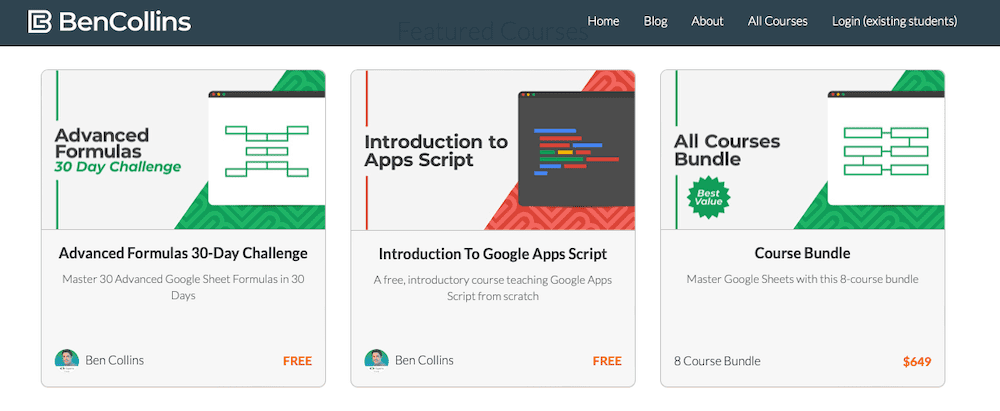
Ad Exchange Networks
As the most popular monetization method, it’s rare to see a blog that doesn’t take advantage of advertisements. Many people turn to advertising and exchange networks to sell “ad inventory”, or the space available on your website for ad banners.
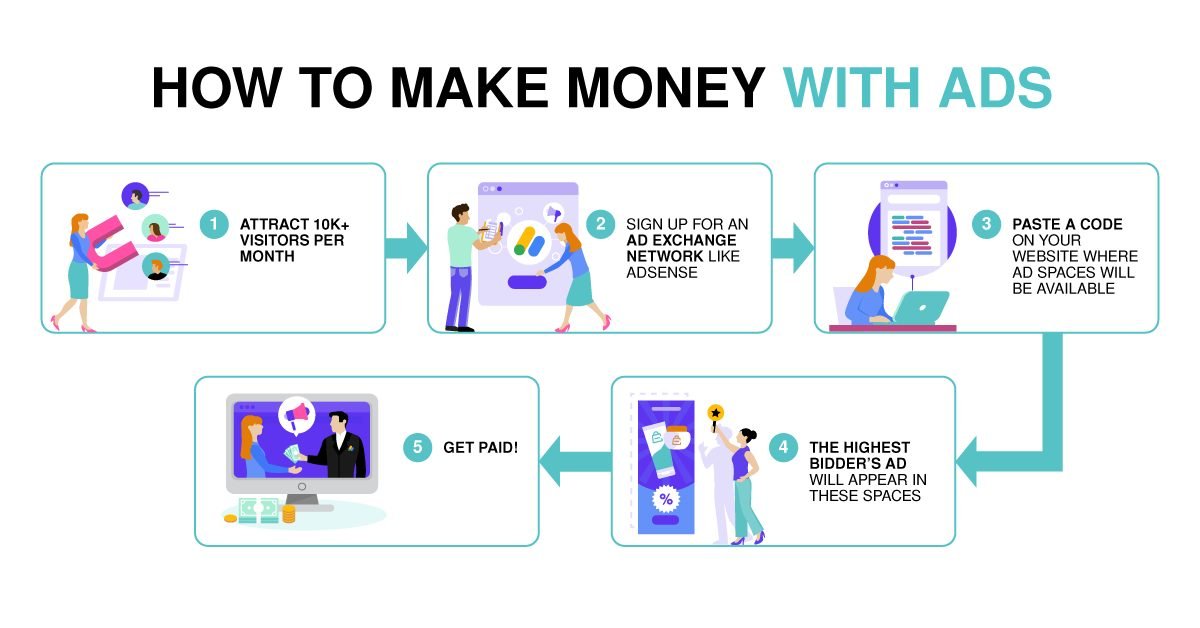
These days, it’s fairly easy to get advertising on your site, with Google Adsense (and the DoubleClick Ad Exchange) being one of the most popular platforms out there.
The blog for Clever Girl Finance uses a bottom bar ad display to bring in ad exchange revenue:

3. Choose Your Name and Branding
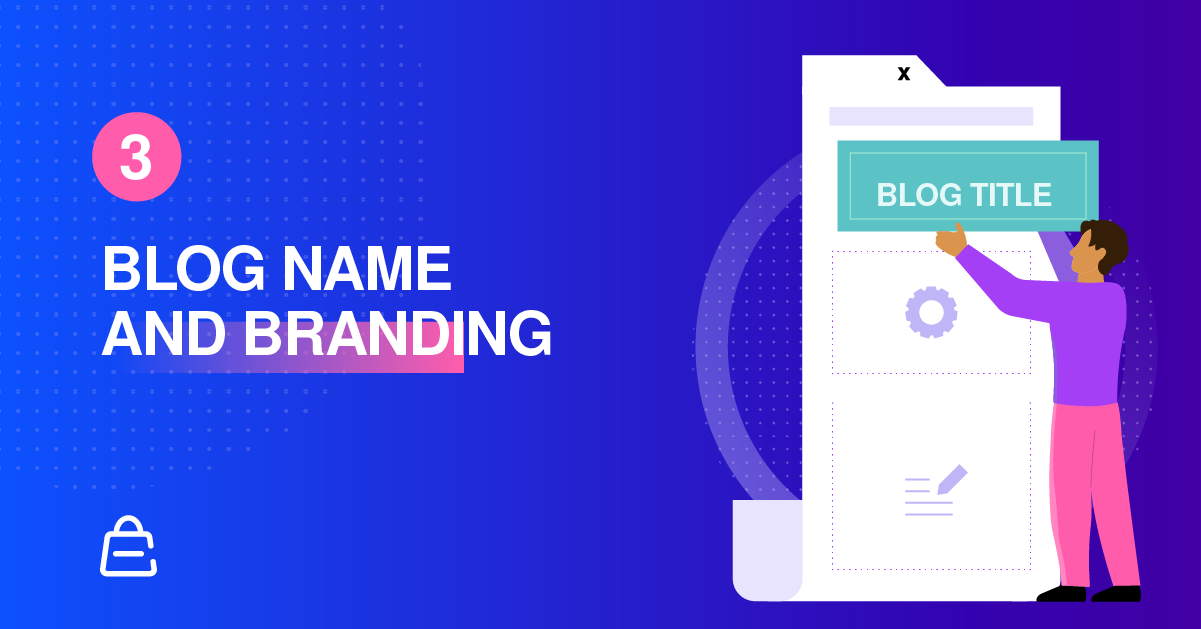
Your blog’s name is the strongest part of your branding. It’s responsible for making your site more memorable, drawing people in, and possibly bringing back lost readers in the future. It can also instantly convey what your blog is about.
It’s a big, important decision, and it’s not likely to hit you in one brainstorming session. Sit down a few times a day and write down some key ideas, words, or phrases you may want to include.
Check out other blogs in and out of your niche, especially potential competitors (use competitor analysis tools to hunt them down), or try a blog name generator to drum up a few extra ideas. Namelix is our favorite option at the moment:
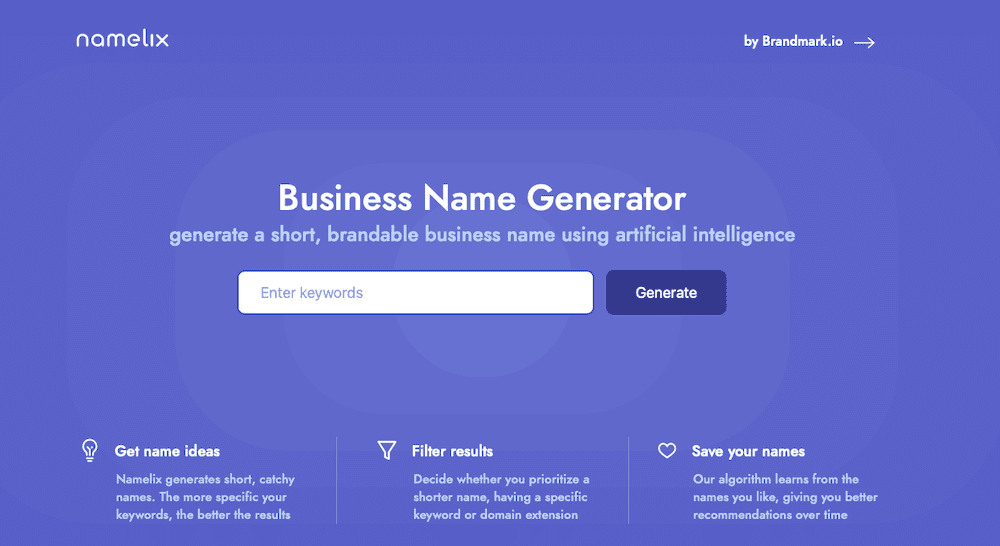
But before you get attached to any name, you should do two things: The first is to Google the name to make sure it’s not already taken, and the second is to run a few desired domains through a domain checker.

4. Select a Blogging Platform
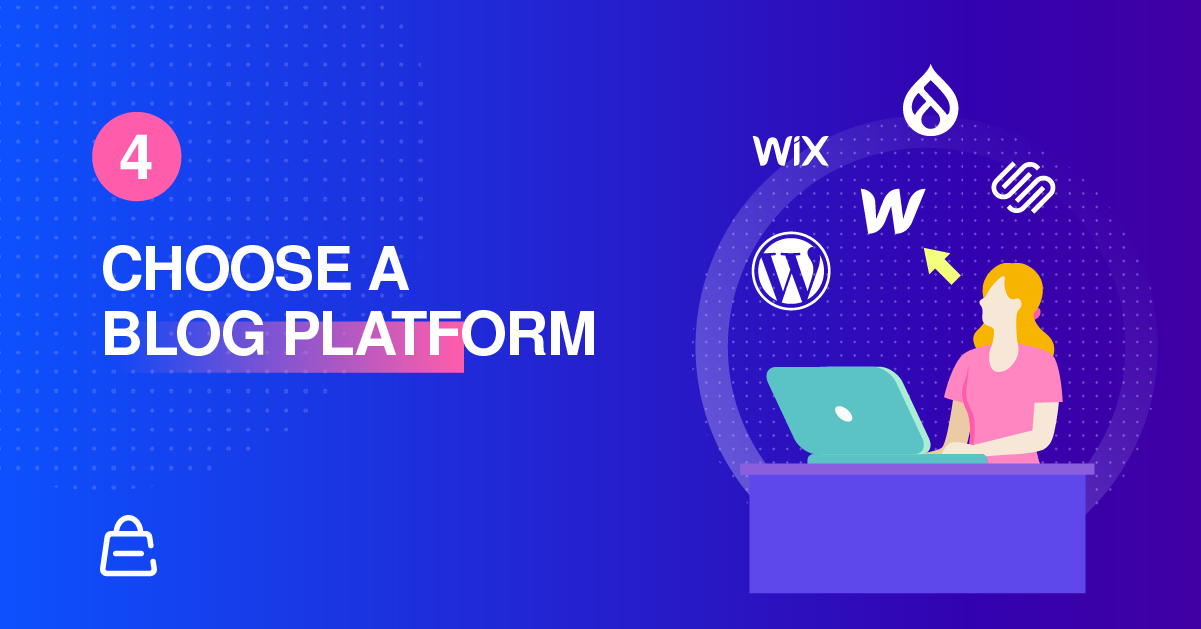
When you have a few solid ideas of what your blog is, its name, and how you’re going to make money with it, it’s time for another big choice: Your blogging platform.
You have quite a few options here. The first, and most difficult option, is to forgo a platform at all and make your own independent website. For many, this is far from an efficient choice, requiring higher startup costs and upkeep due to needing to hire a developer.
Blogging software enables you to design an attractive blog from scratch at a much lower price, possibly even for free by yourself. No major web design or development skills are required, and WordPress plugins can implement any functionality you can imagine.
WordPress is by far the most popular blog platform and content management system (CMS), followed by Shopify, Wix, and SquareSpace. Joomla and Drupal are also quite popular, and there are hundreds more beyond them.
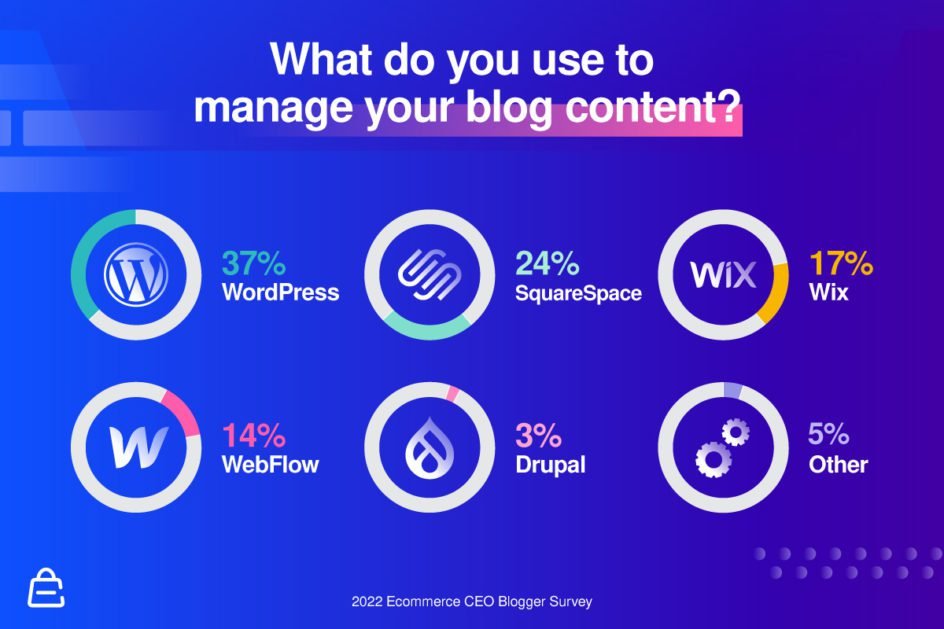
In our survey, the majority of respondents (37%) preferred WordPress. SquareSpace was also a popular choice at 24%.
CMS Options
If you’re looking for the easiest and cheapest way to learn how to start a blog, a majority of people will recommend WordPress over Wix. What’s the reason for that?
Whether it’s truly the best CMS out there is up for debate. Shopify is primarily ecommerce-focused.
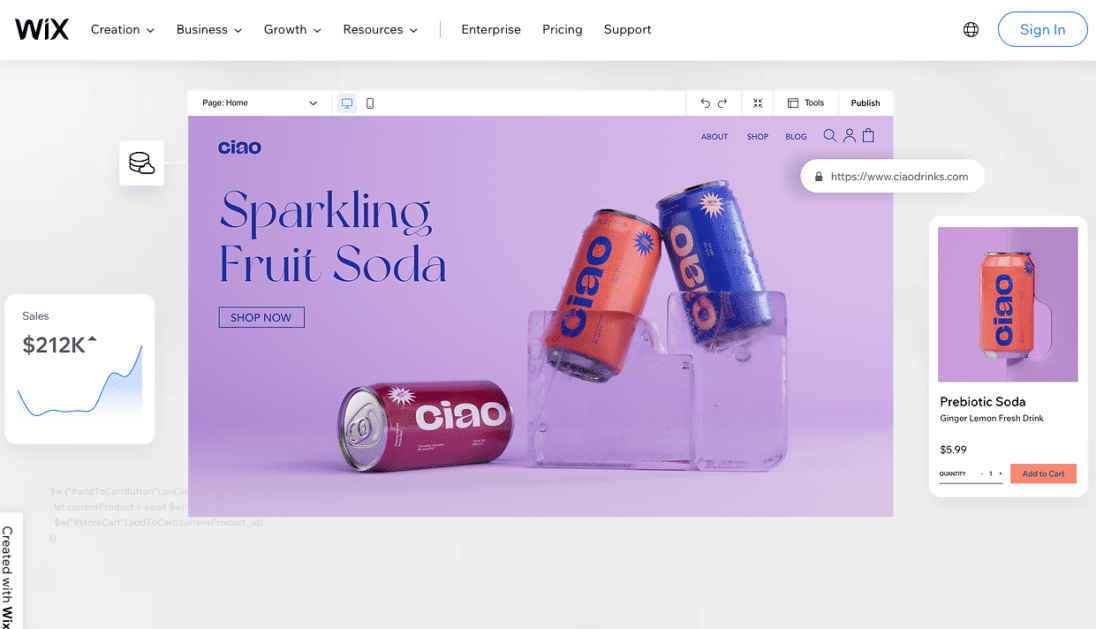
SquareSpace and Wix are easier to use than WordPress, and Joomla and Drupal are better suited for certain niches. Webflow is another, newer option as well.
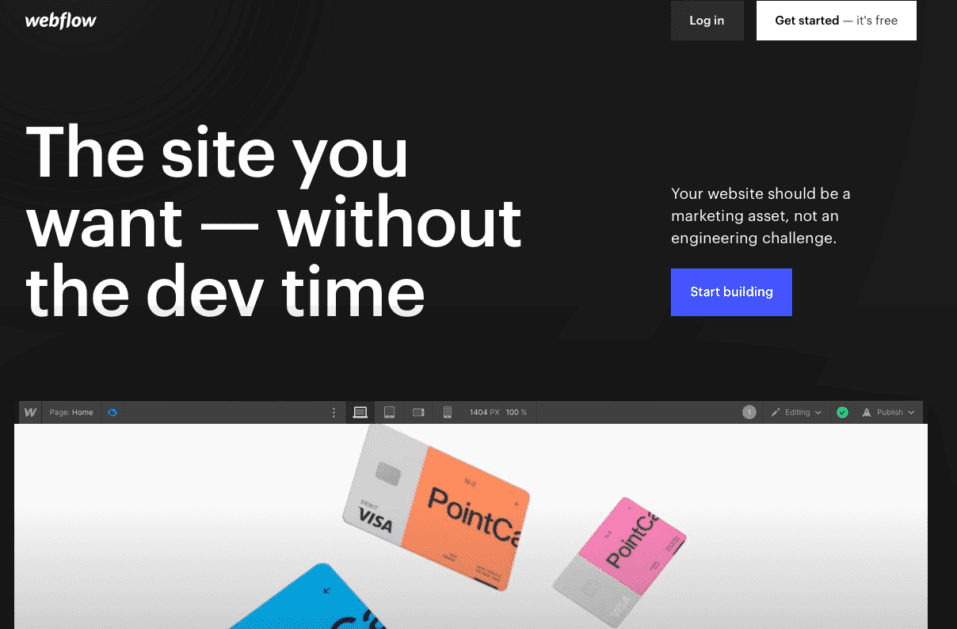
What’s not up for debate is the overwhelming popularity of WordPress, which is used by 43% of all websites and 65% of all CMSes/blogging platforms. Its runner-up, Shopify, is only used by 4% and 7%, respectively.
WordPress features a thriving open source community of developers and designers that keep it well populated with new themes and plugins – many of them free – and constant updates ensure that it won’t become outdated software any time soon.

It’s free to download, so all you need to worry about is hosting costs, and it’s also fairly easy to get the hang of even if you have zero experience.
That’s why WordPress is so widely recommended, and why millions of people use it as the go-to option when starting up their blog.
5. Select Your Host
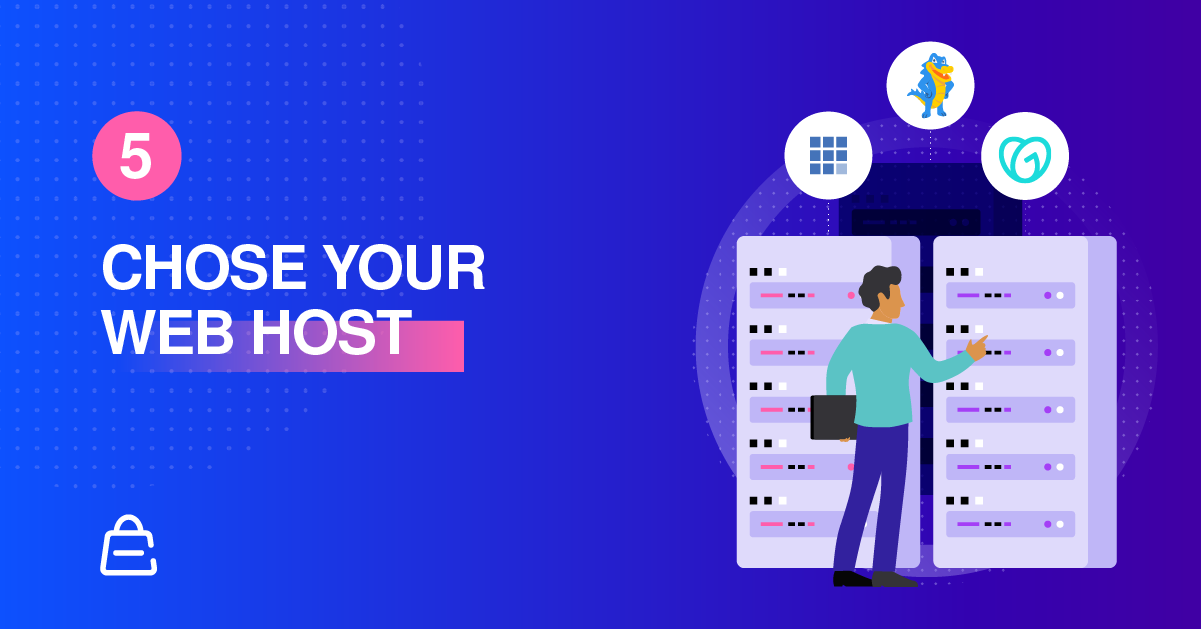
Web hosting impacts everything. A bad web host will lead to extremely slow loading speeds with droves of lost readers, poor customer service that leaves you hanging, and even your website getting hacked and your data being lost or stolen.
A good web hosting company, on the other hand, offers secure servers, helpful customer support, the tools you need to run your site efficiently, and keeps your site running fast with minimal downtime.
Getting locked into an annual plan with a slow host is the last thing you want. That’s why you need to consider your options carefully before making any hasty decisions.
How Web Hosting Works
Ever wondered how websites work? They’re essentially just a bunch of images, text, and code. These are stored in a specialized type of computer known as a server, which allows people to connect to it through the DNS (Domain Name System).

Every server has an IP address, a series of numbers unique to it, which you can use to access it. Since memorizing a bunch of numbers for every website would be impossible, these are mapped onto custom domain names (such as “www.google.com”).
People then use a web browser like Google Chrome, Edge, or Firefox to access this domain and see your website.
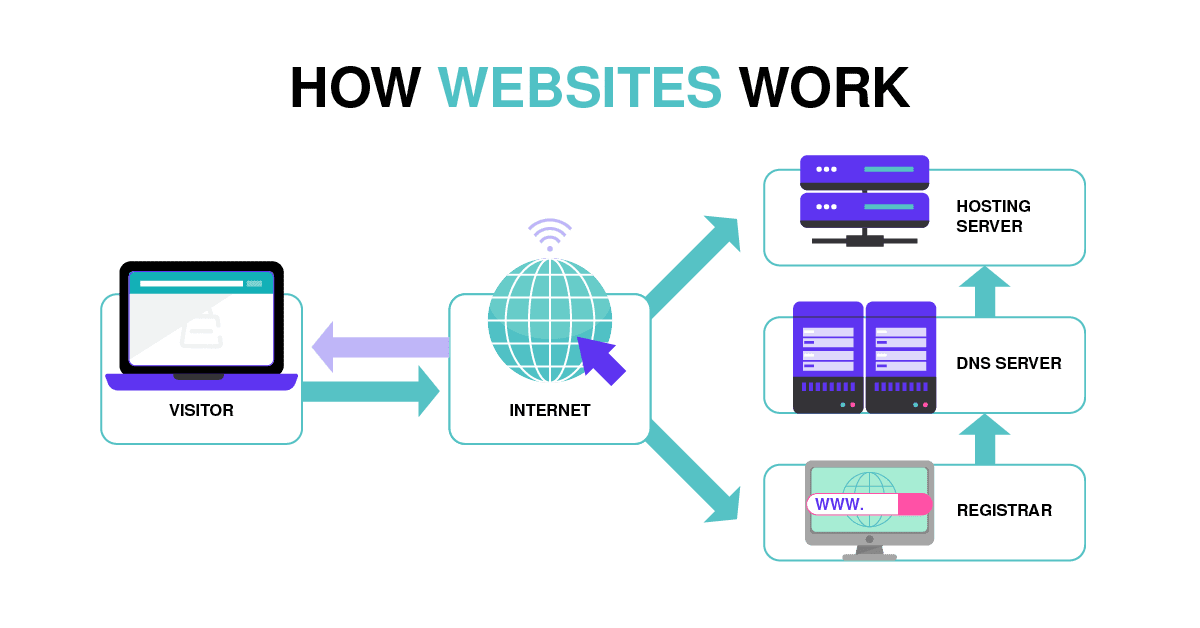
When you purchase web hosting, you gain access to a server to store your site’s files on, and you also purchase a domain name to go with it.
The underlying tech is very complex, but that’s the basics of the web hosting system!
Domain Registry
Oftentimes, blog hosting plans will come with a free domain name. But first, a quick word about what a domain registry is and how it works before we move on. A domain registry is made up of a few key components that work together, including:
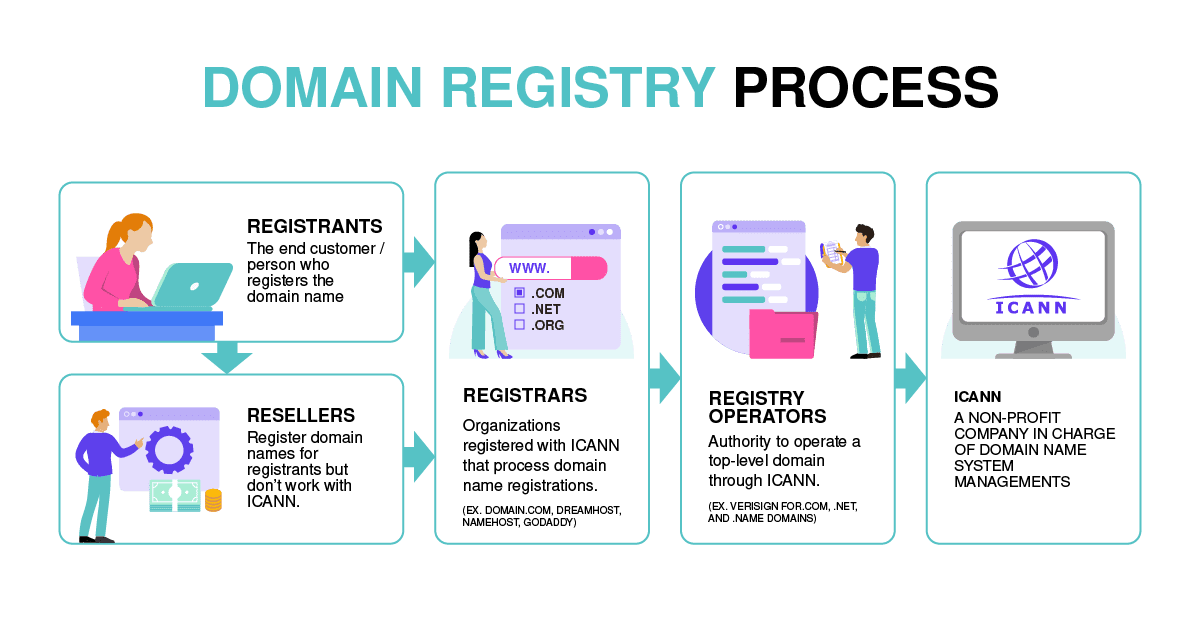
- ICANN: a non-profit company in charge of domain name system management
- Registry operators: in charge of maintaining a database of all domain names
- Registrars: Orgs registered with ICANN that process domain name registrations
- Resellers: Register domain names for registrants but don’t work with ICANN. (Web hosting companies)
- Registrants: The end customer/person who registers the domain name.
Types of Web Hosting
Once you start researching blog hosting, you’ll quickly come across the multitude of different types available. Picking the right type of hosting is almost as important as choosing the right host.

The four most common types of hosting, and the ones you’ll encounter most often, are shared, VPS (Virtual Private Server), dedicated, and cloud hosting.
- Shared hosting is cheap, easy to get, and involves minimal setup, which makes it appealing for beginners. The downside: It can be very slow and insecure. You and dozens of other websites all share a single server.
- VPS hosting rests somewhere between a shared and dedicated server. While you still share server space, virtual servers are isolated so you’re not as affected by other websites. They’re a little more expensive, but it’s often worth the investment.
- Dedicated servers offer an entire physical server all to yourself. They pack a big punch with far more resources, but it’s also the most expensive option.
- With cloud hosting, instead of residing on one server, your website’s resources exist across a network of physical and virtual servers. This makes it scalable; you can start out purchasing only the resources you need then easily add on bandwidth as you grow.
Lastly, you have managed vs. unmanaged hosting. This is an extra layer on top; for instance you could have managed VPS hosting or unmanaged dedicated blog hosting.
In a managed server, the hosting company handles most of the upkeep, installation, and management. With unmanaged hosting, all you get is basically a server with an operating system installed on it. Though less expensive, it’s up to you to set everything up.
Paid Hosting Plan Options
It’s a good idea to do your own research when it comes to web hosting, since there’s a lot of conflicting and biased information out there. There are third-party sites dedicated to running objective and fair benchmarks on web hosts.
You’ve probably heard of the popular web hosts like BlueHost, HostGator, or for WordPress-specific hosting, WordPress.com. But if you’re looking for high-quality managed hosting for WordPress, these are a few personal recommendations that are fast and reliable.

For total beginners, Nexcess is one of the best. It’s fully managed and monitored, so all the setup and maintenance is taken care of for you, and it scales with you as your site grows. There are also no traffic limits or overage fees.
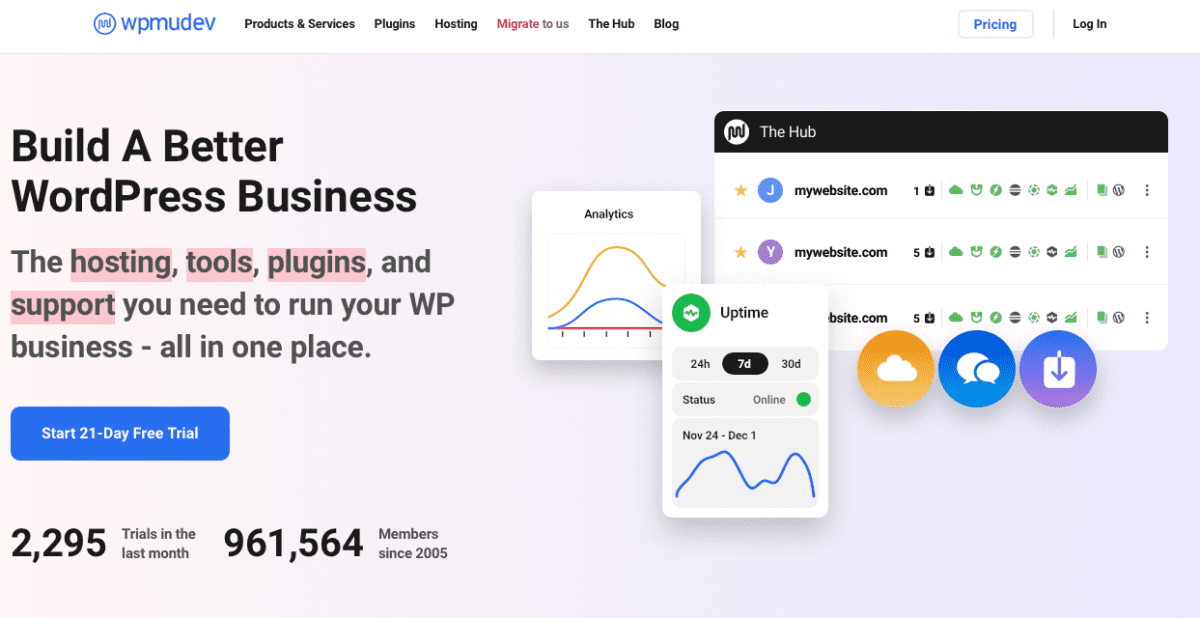
WPMU DEV is an all in one platform that covers absolutely everything from web hosting to client portals to even specialized plugins that can take care of issues like image optimization or CDNs. A platform like this keeps things simple with all the functionality you need in one place.

Kinsta’s primary marketing point is its finely tuned, blazing fast servers and secure managed hosting. Made for businesses of all sizes, Kinsta is a great choice if you’re looking for security and speed.
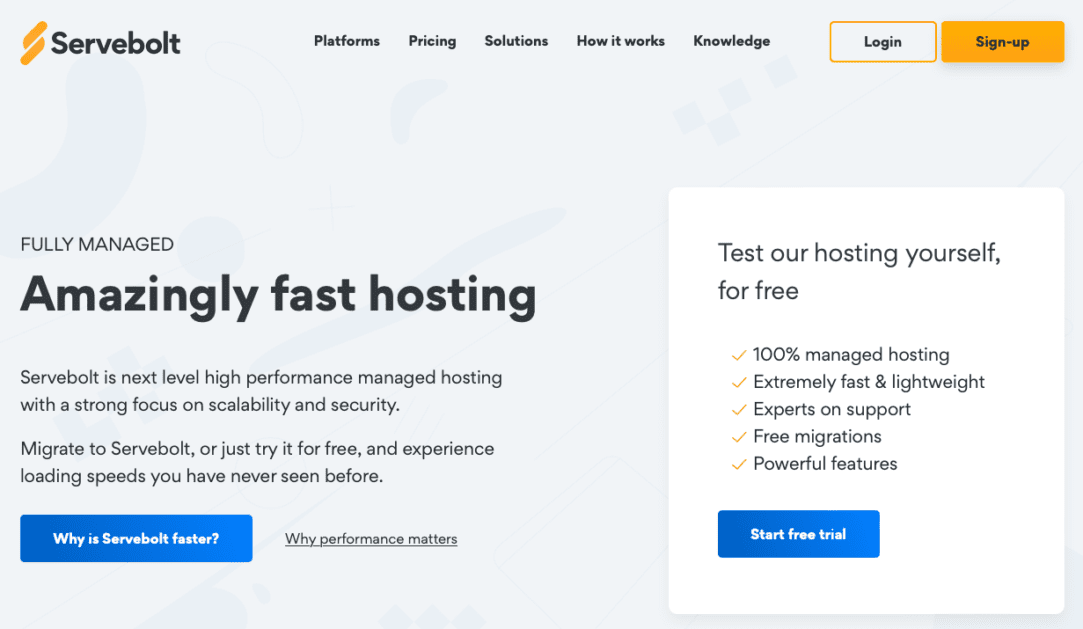
While it’s more geared towards developers, this is personally the fastest hosting I’ve ever used. If “serviceable” speeds won’t cut it and you can do without the hand-holding most managed hosts offer, this is the one. The Accelerated Domains technology really seems to work.

With its 30-second support response, WPX puts a great deal of its focus on providing great support through live chat. And it’s not just that; it’s also a very fast web host. If good support is important to you, this is definitely a top choice.
6. Set Up Your Blog

You have a host and a domain and you install WordPress. Now with the dashboard open and ready to be customized, it’s time to complete the setup process for your self hosted WordPress blog.
With WordPress, the underlying core of your website relies on a theme. You’ll need to pick a good one out to get the right head start on designing your dream blog. From there, you can get the hang of the default tools provided to you.
We’ll get into the nitty-gritty of how to design important blog pages on your site, but let’s cover those basics first.
Customize Your WordPress Blog Design
Pay attention to two key areas in WordPress site dashboard: The Appearance menu, and the post/page editor.
In the Appearance menu, you’ll find several helpful options: The Themes page where you can switch to a new WordPress theme, Widgets and Menus to add navigation or tools to certain areas like the sidebar and footer, and the Theme File Editor if you ever need to edit your theme’s code.

But the most useful of these will be the Appearance > Customize page. Here you can change the color palette of your WordPress theme, set a background image or cover template, or even add custom CSS. Available options depend on your theme, but if you want to change how something looks, it’s a good idea to start here.
There’s also Gutenberg, WordPress’ drag and drop block editor. It’s not quite a page builder, but it can get you far enough in design.
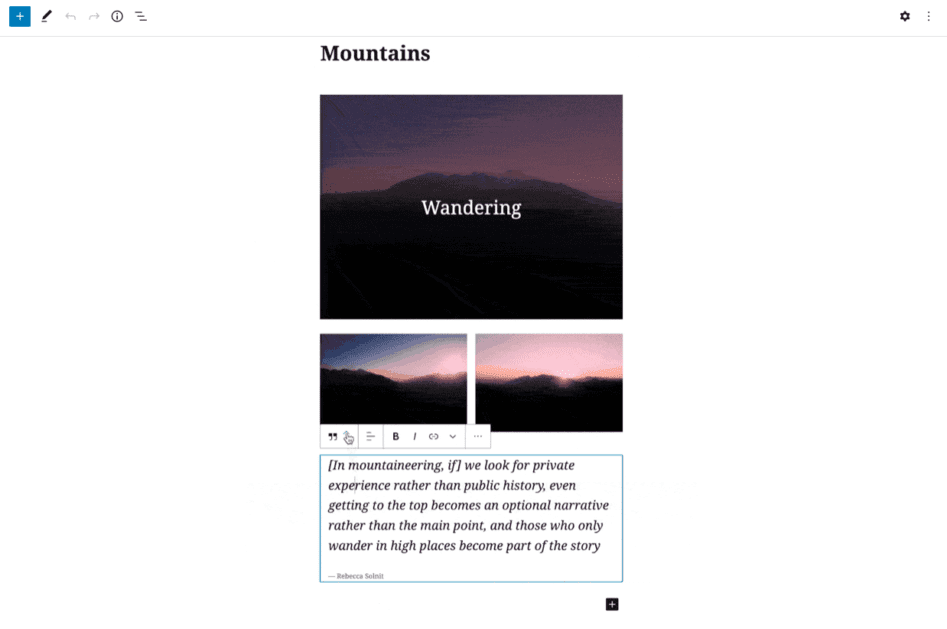
To get started, go to Posts > Add New or Pages > Add New to launch Gutenberg. Tap one of the plus icons to add a block, and pick from basic ones like Paragraph or Image or complex ones like Calendar and Gallery.
Click a block and use the arrows to move it up and down, or the Drag tool to drag it around. Pay attention to the context menus on the right to tweak each block. That’s the basics of the Gutenberg editor.
Kadence Themes (Recommended)

The right theme is the basis of a good blog design. This determines not only how your site looks but also how much control you have over customizing it.
Powerful themes like Kadence come bundled with customization options: Templates, visual settings, layout design, and a drag and drop header and footer creator. It integrates with several page builders if you want the finer control, but comes with many expansive options by default.
And it’s not just the back end; Kadence is beautiful and clean, with many business- and blog-focused templates. Several other plugins such as Kadence Blocks give you even more customization options.
GeneratePress

If other themes are too bloated for you, GeneratePress is a lightweight foundation for your design.
Much like Gutenberg, it uses a block-based builder to create layouts and pages. In the pro version, you can use the Site Library to set up an entire website in seconds that can then be personalized to your brand, and also use the theme builder to create reusable templates.
Astra Themes
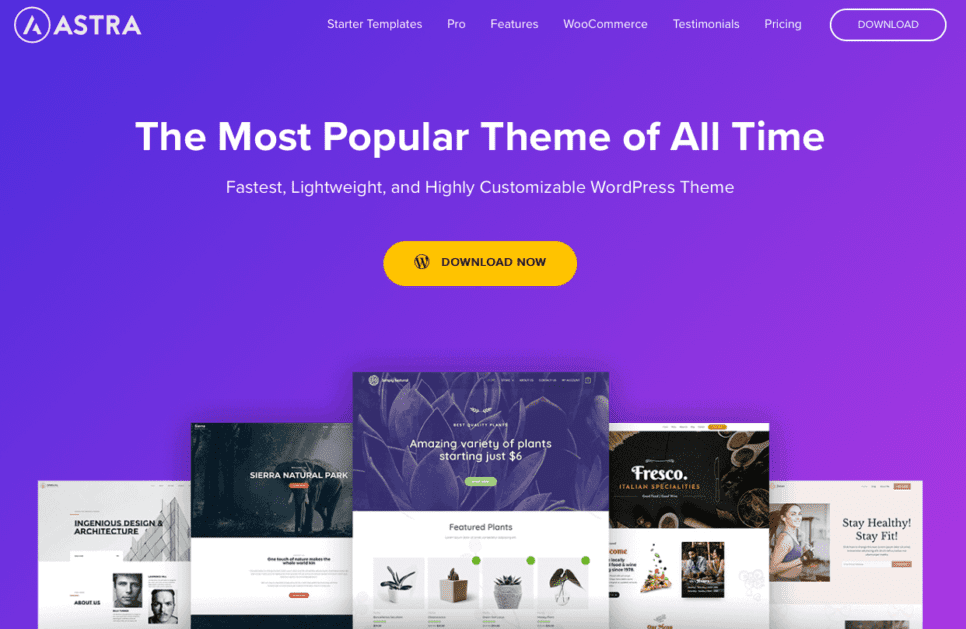
Astra focuses on customization. It expands the default theme customizer, giving you more control over how your site will look in the end. And there are nearly 200 templates to import, some for the default Gutenberg editor and some for plugins like Elementor or Beaver Builder.
It’s also pretty well optimized for how much it offers, so it won’t bog down your loading speeds.
Decide on the Features You Want to Include
Now that you’ve got a grip on customizing your theme in WordPress, you should decide what sort of features you want your blog to have.
Think about blogs you’ve read or even websites you’ve enjoyed browsing before. What stood out to you? Brainstorm a list of what you want to add, for example:
Now that you’ve got a grip on customizing your theme in WordPress, you should decide what sort of features you want your blog to have.
Think about blogs you’ve read or even websites you’ve enjoyed browsing before. What stood out to you? Brainstorm a list of what you want to add, for example:
- Fonts, color palettes, graphics, and other aspects of your visual design
- Email list/newsletter subscription
- Special blog sorting, navigation, categorization, and search features
- Ecommerce tools like WooCommerce.
- Integrations with other business platforms
- Social media icons and sharing tools
- Forums, user-submitted content, comments, or other community engagement tools
- Extra security plugin features as well as automated backups from backup plugins
- Live chat, email support, or other customer support options via contact form plugins
- Analytics integrations and monitoring, such as Google Analytics
- Other small features like author bio boxes, image lightboxes, and so on
Plugins, Add-ons, Extensions
If you asked what WordPress’ most defining feature is, many would answer its blogging and CMS system, or perhaps its massive community. But another valid answer is the sheer volume of plugins, themes, and other third-party extensions it has.
On WordPress’ plugin repository alone, there are over 59k plugins, and every one of these is free to download. Adding helpful features to your WordPress site can increase blog traffic and aid you along your blogging journey in a number of ways.

There are also sites like CodeCanyon where you can find thousands more paid plugins, and many other repositories exist out there, packed full of WordPress content.
As for themes, it’s much the same. You can find nearly thousands of themes for free in the official repository, and if you want a premium theme, these are collected on sites like ThemeForest and TemplateMonster.
And some of the best plugins and themes WordPress has to offer aren’t found in any repositories, but on their creators’ websites. There’s a wealth of content just waiting to be found, but the sites listed above are a great place to start.
Too many plugins can slow down your site, so try not to go overboard – it’s very easy to get lost in the vast plugin repository – but pick out a few. You can find and activate plugins in the Plugins > Add New screen in your back end dashboard.
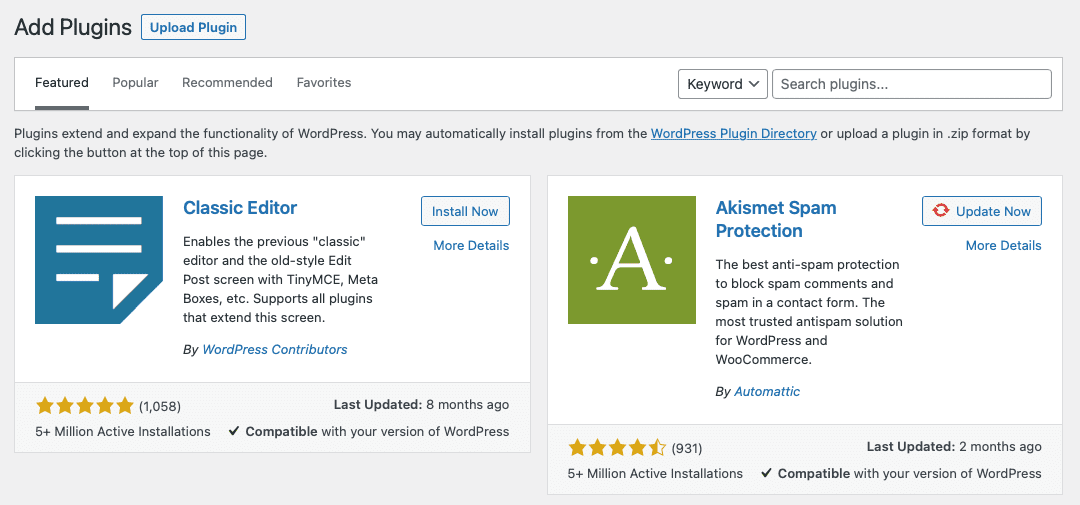
Setting Up Main Blog Pages
Now it’s time to create a few key pages your blog will need to thrive. While the small design specificities are up to you, here are a few tips to get everything up and running.
Home Page
Designing a good homepage is an art on its own, so take a look at your competitors’ websites for inspiration and keep these step-by-step instructions in mind as you develop this piece of content.
- Introduce yourself or what makes your blog unique immediately. Leverage your experience. Tell users why they should stick around.
- Include at least one call to action above the fold.
- Display your most recent blog posts or a collection of your best.
- If you sell products or services, link directly to these pages.
- Add testimonials from happy readers and customers.
About Page
Who are you? Why should readers listen to you? What is your mission? And why did you start blogging?
Many readers want to form a connection with their favorite blogger, so talk about yourself a little. This is also a good place to flaunt your years in the industry, education, or any other relevant experience. Ensure it is high-quality content.
Blog Page
Carefully design blog pages so they offer a pleasant reading experience with a distraction-free design.
- Make reading comfortable. Choose a font and colors that won’t cause eyestrain. Consider offering options such as dark/light mode, font switcher, and text size adjustment.
- Add a summary box so readers can get a quick idea of what the article is about.
- Minimize distractions. You want readers to focus on your blog and nothing else. Change opt-in popups so they appear at the end of the article. Disable the sidebar. If you have a sticky header, minimize its design on scroll. Avoid animations or flashing lights.
- Use widgets to encourage users to comment, share on social media, browse products, or read another article at the bottom of the page.
Header
The header sits at the top of the page, and visitors intuitively turn to it when trying to navigate a website. With that in mind, here’s what you need to put in it.
- Design clean navigation menus; too many pages and giant dropdown menus can be overwhelming.
- Add a search bar so users can quickly start browsing.
- If you run a store, add shopping cart and login links.
- Insert a logo to solidify your branding.
- Use a minimal design, and don’t clutter up your header with too much text or too many widgets.
Footer
Finally we have the footer. While this often ends up as a dump for random links and widgets, it has a very important purpose. Users look to the footer when searching for information on your brand.
- Include links to a few of your most important pages (login page, sitemap, a few navigational pages). Add a second search bar if it’s not easily accessible from the bottom of the screen.
- Place your contact and important business information here, or link to a separate page. You may want to include a mini contact form.
- Add legal pages like your copyright notice, terms of service, and privacy policy.
- Insert some sort of push to keep browsing or return later: a signup form to gather email subscribers, a latest articles widget, a donation button, etc.
- Use social icons and link to any related sites. You might even include a social feed with a small gallery or a single post.
SEO Plugin Set Up
One thing you’ll definitely want to do is set up an SEO plugin. WordPress’ SEO features are a little bit lacking by default, but this can be easily rectified by an extension like Rank Math.

With this, you can set up a sitemap, edit important metadata for your posts, and also get real time guidance on SEO as you write.
SEO is really important since it affects your organic traffic, or traffic you naturally generate from search engines. Without organic traffic, you have to rely entirely on manual marketing. Better SEO means higher spots in the organic search results, more eyes on your content, and more money.
Rank Math
Download Rank Math by navigating to Plugins > Add New. Search for it, click the Install button, then click Activate when it finishes installing.
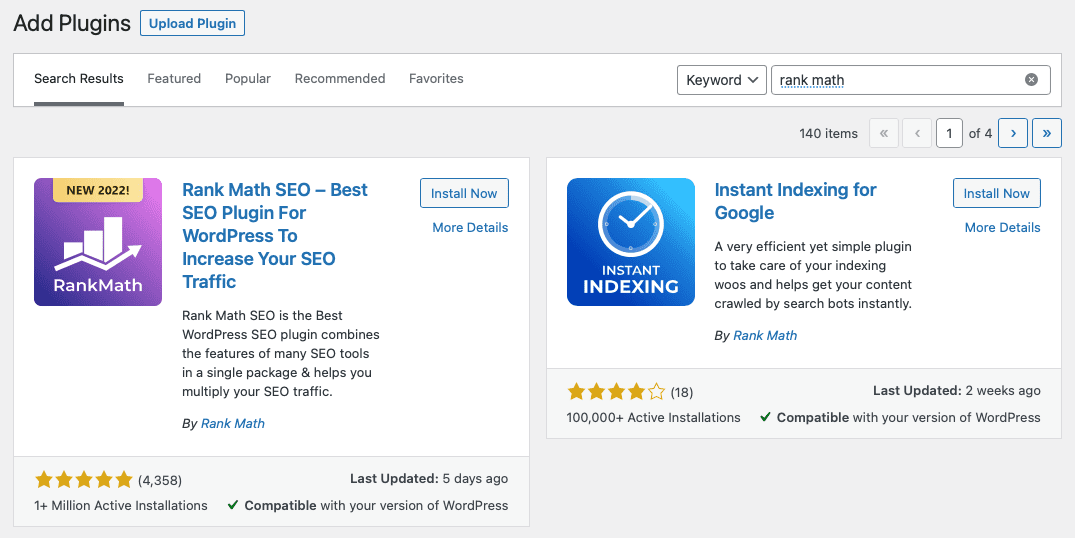
You’ll be immediately launched into the setup wizard. It’s a good idea to create an account, as it gives access to extra target keyword suggestions and the SEO Analyzer which will scan your site for SEO errors. Otherwise, run through the wizard and set up all your settings.

You should familiarize yourself with the new Rank Math tab in your dashboard. Let’s go over a few of the most important settings and features.
Noindex Tag and Category Pages
Unless you plan on fleshing out tag and category pages, filling them with valuable copy and a call to action, it’s best to prevent them from being indexed by Google.
The default category pages can be very bare, little more than a list of articles that may not even visually match your theme. They can also compete with your more important pages for rank.
In Rank Math > Titles & Meta under the Global Meta settings, make sure to check the setting Noindex Empty Category and Tag Archives.
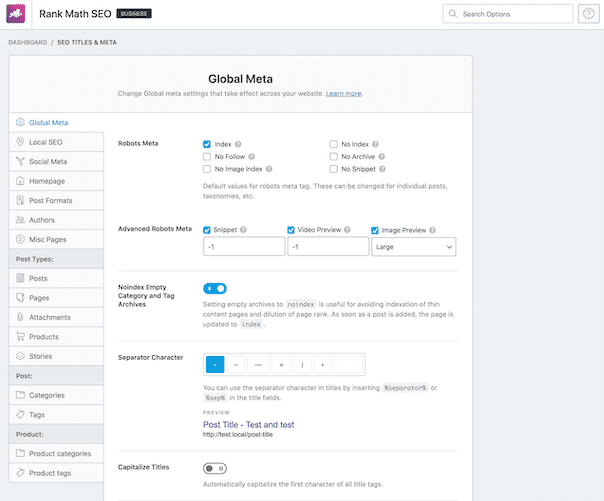
But if you want to noindex all category and tag pages, click the Categories or Tags section at the bottom of the Titles & Meta page. Turn on Category/Tag Archives Robots Meta, then untick the Index box and tick the No Index box.
Sitemap
An XML sitemap lists out all the pages on your site so that search engines can crawl them easily. Rank Math will automatically create one for you.
When you first run through the setup wizard, you’ll be presented with some basic sitemap settings. You can choose whether to include posts or pages, images, or taxonomy pages like category pages.
You’ll find more settings on the Rank Math > Sitemap Settings page if you want to edit this in more detail. You can change how many links are on each page, exclude certain pages or terms, or include items like tag pages or attachments.
Edit Post and Page Metadata
One of Rank Math’s key features is the ability to edit metadata and get SEO suggestions for what you’re working on.
You can change global default settings on the Rank Math > Titles & Meta page under the Global Meta tab. Here you can change index, archive, and snippet meta settings among other options. On the Posts, Pages, Attachments, Categories, and Tags pages, you can change the default title, description, schema type, and more.
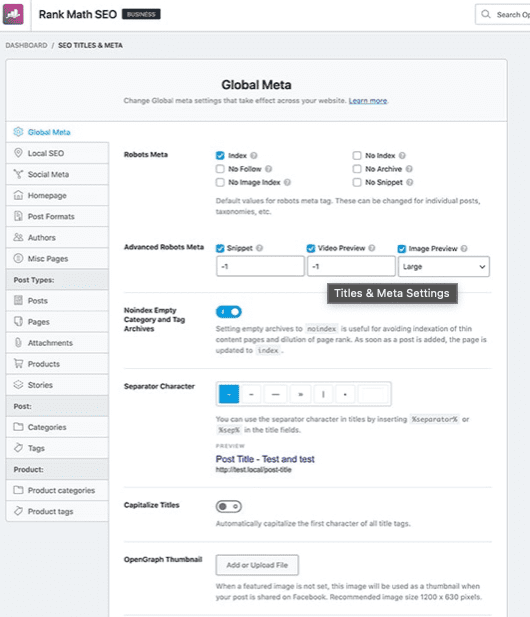
What about metadata settings on an individual scale, plus SEO analysis? Go to any blog post or page and click the Rank Math icon in the top right corner. The first tab will offer suggestions to improve SEO, while you can edit metadata and other settings on the Advanced, Schema, and Social tabs.
Make good use of the SEO analysis and try to get a high score on all your articles. A perfect score doesn’t automatically mean better rankings, but these guidelines are designed to push you towards SEO success.
7. Content Planning And Strategy
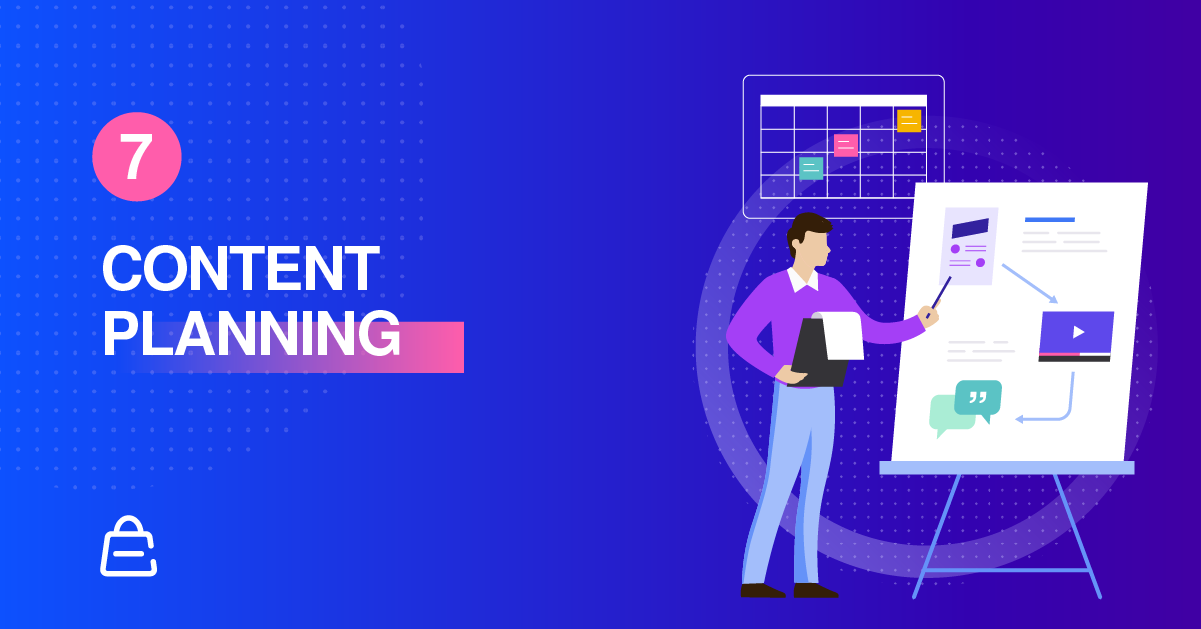
With your website all set up and ready, now you just need to populate it with blog posts. You’ve already done some basic research into your blog niche, but deeper research is required once you get to the content planning stage.
When you’re monetizing a blog, content marketing is your primary way of drawing in customers and guiding them towards a sale. A list of topics is a good start, but it’s important to think about what your ideal readers are looking for and what issues you and your knowledge are able to solve.
Content strategy will be a large and ever-evolving part of your successful blog, so you’ll need to properly understand how to hit the sweet spots search engines are looking for and optimize SEO.
Perform SEO and Keyword Research
Every content strategy starts with SEO research, plain and simple. To do this, you’ll need to use a keyword research tool like Ahrefs or one of the multitudes of similar platforms. The site, keywords, and content explorers on Ahrefs will be your best friends here.

To do SEO research, you’ll need to have a good idea of the niche you’re trying to fill (that’s step #1 in this guide!) and the sort of content you’ll be creating. Use the list of blog topics and theme ideas you made earlier to draft up a few potential keyphrases.
Plug these into a keyword or content explorer, and you’ll see how these phrases are ranking, a few related keywords or variations, and some suggestions on which topics you’ll want to target.
This is valuable information and a huge source of potential topic ideas, so write down everything. Some keyword research tools are more in-depth than others, so try a few out and get a good idea of what readers in your industry are searching for and what gaps in content you could fill.
Consider Search Intent
When doing keyword research, search intent is one of the most important things to understand. Behind every search phrase is a person trying to solve a problem.
Your job is to look past the screen and try to figure out what they’re trying to do and how you can address it. This is how you create high-converting blog posts.
For instance, you can mine all the high-ranking keywords and stuff as many as possible into your articles, and you may get a few clicks for it. But if you don’t actually answer the user’s underlying question, they’ll leave dissatisfied, and that’s a lost conversion.
To understand search intent, you need to know your audience. Social listening and analytics gathering can help in this regard.
There are several different types of search intent, and you should understand how to optimize for all of them.
Write What You Know
Your greatest source of compelling content ideas will come from within. Trying to break into an industry you know nothing about will likely leave your content not quite living up to expectations. But if you write about topics you’re more familiar with, your authority on the subject will shine through.
Many blogs are about teaching and helping others in one form or another. Consider your experiences, skills, and what you have to teach.
But don’t be afraid to lean on expertise when necessary. Reference other written works, do your research, and acknowledge when others know more than you. Reach out and ask questions if needed.
You can use their knowledge as a helping hand to gaining a broader understanding and improving your own work.
Plan Out Content Silos
Structuring your website well provides SEO benefits while also making your site easier to navigate. Content silos are one way of structuring blog posts, and it can give a good idea of what pages you might need to flesh out.
In a content silo, you create a hierarchical website structure which you fill with categories, sub-categories, and pages.
For example, say you run a cooking blog. You may have two major categories: “Recipes” for quick how-to guides, and “Cooking Guides”. “Recipes” could be further separated by type of food, while “Cooking Guides” could have several sub-categories for cooking basics, reviews, and so on.
It all depends on your specific blog and how you want to lay it out.
Target Less Competitive Keywords
When you’re starting out, your first instinct may be to target the highest ranking keywords. But breaking past the industry giants and making it into the top spot in the search results can quite the endeavor – it may even be impossible.
Tackling this will be a job for far later. Instead, try to target keywords that are a bit less competitive and where the competition has left clear gaps that you can fill.
While the reward may not be quite as great, a #1 spot on any keyword ranking, no matter how obscure, will earn you far more traffic than trying to fight over top spot in a heavily saturated keyphrase that’s already had all the SEO squeezed out of it.
Rank Pillar Pages
Pillar pages make both users and SEO algorithms happy. These long-form articles broadly cover a key subject, linking out to other pages on specific sub-topics as needed.
Users love them because they’re provided with an in-depth tutorial with links to more resources. And it’s great for your SEO because it gives plenty of opportunity to add internal links, which keeps that link juice flowing and users browsing.
Pillar pages are the cornerstone of a “topic cluster”, or a bunch of related articles on one subject. Usually they cover a very wide-reaching subject, while several smaller articles go more in detail on sub-topics.
As you launch your blog, focus on ranking 5-10 pillar pages, and then creating an additional 5-10 blog posts for each pillar page. This should keep you busy for a while! And if you ever run out of ideas, start putting together another topic cluster.
Understand Topical Authority
Google’s SEO practices are a big mystery, but many aspects of its algorithm have emerged. Topical authority is one, and it can have a big impact on your rankings.
When someone uses a certain search phrase, Google prefers to rank pages from sites with more articles in that topic. The more expertise you have on the subject, the more likely Google will push your blog to the top.
Google can recognize the topics and sub-topics your website generally blogs about, though good categorization and pillar pages can give them a nudge in the right direction. If it recognizes that your site is pushing out a lot of high-quality, high-ranking, compelling content on a certain subject, you’re rewarded with a huge boost in some keywords.
While this can make it quite difficult to win out against long-running blogs with hundreds of high-ranking articles, it does mean that focusing on a specific subject, fleshing out topic clusters, and picking the right target keyword will reward you greatly.
8. Write Your First Blog Post
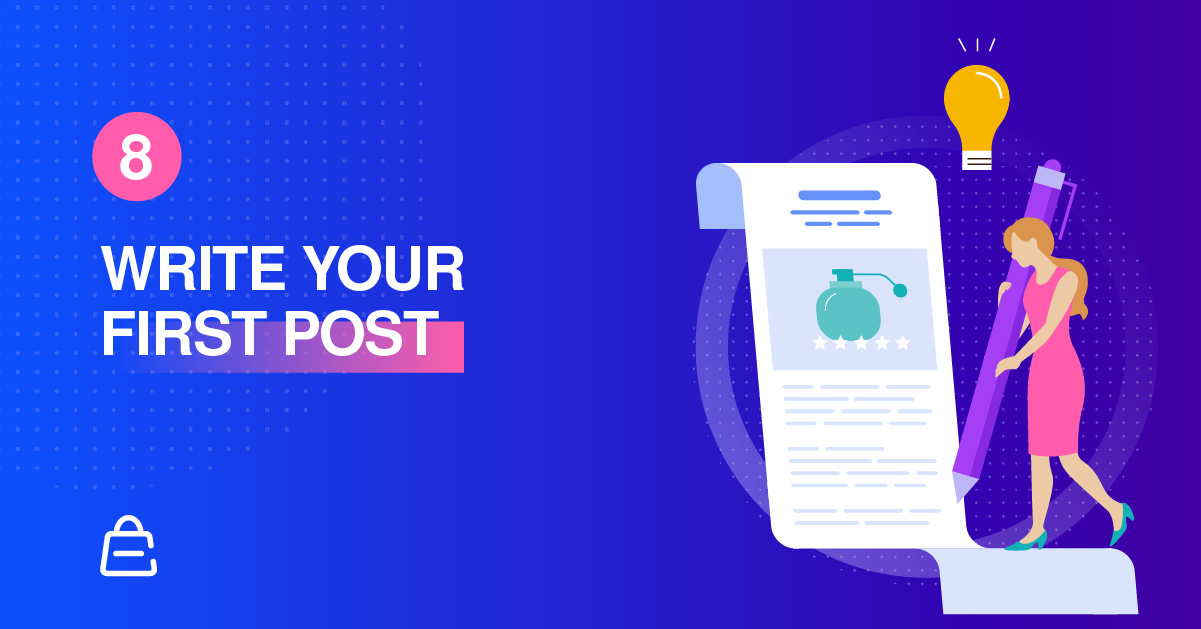
Before writing your first post, you should have a list of pillar pages and topic clusters you’ll want to start with. You don’t need a schedule or an entire content calendar yet; just have some direction of what posts you’ll be writing.
You may also want to consider creating a writing style guide, so you always keep your formatting and tone consistent. This can be very simple or an entire detailed document.
Once you’re all ready, pick a topic you like and start blogging!
Writing Blog Posts: A Cheat Sheet
Writing is a skill that takes time to develop, so the best thing you can do is get out there and start doing it. But if you’re struggling to know where to start, try following this cheat sheet for a few ideas.
- A Compelling Title – Don’t be the thousandth “How to Start a Blog”; add something gripping to your title. This could change the premise and tone of your article, so it’s good to have a unique title from the start.
- Structuring and Outlining – First thing, lay out the structure of your article. Begin with an introduction and end with a summary. Between, use headings and subheadings (H2, H3) to answer questions and lead into explanations.
- Writing – Flesh out each section, addressing readers’ issues and answering their questions. Write in smaller, readable chunks, keeping individual sections below a few hundred words and paragraphs less than 5 lines long.
- Calls to Action – End your article with a relevant call to action: Leave a comment, purchase this product, browse the store, sign up for the newsletter, read more about this topic.
- Visual Interest – Include images, tables, bulleted lists, and other visual content throughout your article. This makes it far easier to read than walls of paragraphs.
- Keywords – Add keywords to your title and headings, and sprinkle them throughout the article. But don’t awkwardly shove them into your article. Google now prioritizes topics over keywords, so prioritize readability over keyword stuffing.
- Other SEO – Add internal links, image alt text, and metadata. Consider creating a checklist and run through it each time you publish.
- Final Check – When you’ve finished your article, step away for a bit. Come back with fresh eyes and read over it, checking for spelling and grammar errors, inconsistencies with your style guide, or awkward sentences. Put it through Grammarly or a similar tool before pressing the Publish button.
Decide on a Publication Schedule
Publishing content consistently is one of the best ways to retain readers. Publishing on a regular basis is all the better for engagement, but it’s far better to post once a month than to say you’ll post twice a week and end up burning yourself out.
In our survey, most bloggers (23%) indicated that they published twice a week. Once a week was also a popular choice, at 21% of respondents.
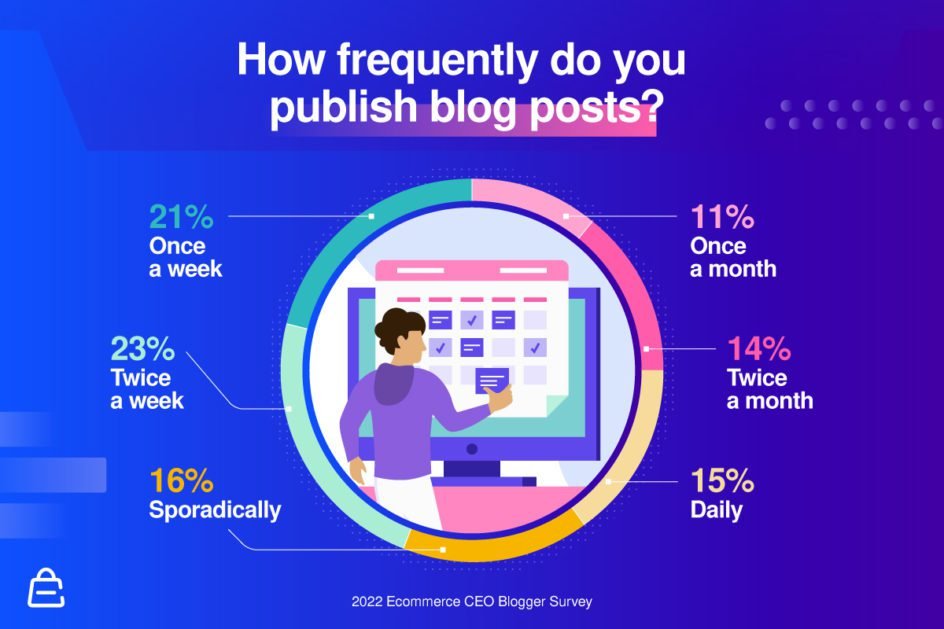
It’s a good idea to build up a backlog of blog content rather than scrambling to write a new article every week. And while you may be excited to dive into your blog and get all your ideas out there right away, try to start slow so you don’t run out of content ideas a few months in.
Eventually, you’ll slip into a groove of writing, editing, and publishing. The trick is to keep at it until this routine is established.
9. Promote Your Blog

With a solid content strategy and great SEO, you’ve already put in enough work to start attracting and retaining readers through organic traffic. But if you really want to succeed, you’re going to need to do a bit more.
There are several marketing methods you’ll want to look into for blog promotion. A few key ones:
- Social media marketing – Promote your blog on a social media platform like Twitter, Facebook, Instagram, Reddit, YouTube, or even TikTok. Video content is especially profitable these days.
- Influencer marketing – Reach out to influencers on social media and enroll them in promoting your blog or products to their followers.
- Email marketing – Retain past readers and buyers with an email list and keep them coming back for more by strategically using newsletters to draw them in.
- Digital advertising – Pay to host ads on other people’s blogs and websites. You can target certain demographics or use retargeting strategies to draw in lost visitors. This is another place where you can incorporate video content.
There’s also one very important strategy bloggers can utilize: outreach and link building. Other bloggers are your most valuable asset in getting more readers. Write a guest post for another blogger, accept guest posts from other sites in your niche, offer your products to influencer bloggers in your industry in exchange for a review, and engage in link building to create backlinks.
Overall – make friends and build partnerships within and around your niche. A little push from a bigger blogger might be all you need to launch your website to the top of the search results. Blogger-to-blogger relationships can really boost revenue of blogging. You can help each other out with guest blog posts, to expand your audience.
Blogging FAQs
Do You Know How to Start a Blog Now?
From start to finish, learn how to start a blog is hard work. You need to do extensive planning, a ton of research, and a lot of hard work setting up the site itself – not to mention the ongoing task of continuing to write articles and market your blog even once the initial setup is done.
And even with all that, it still takes a bit of luck to really take off enough to generate a lot of money. But don’t be discouraged. Research, planning, and targeting a niche you know your audience will be interested in is often enough to beat the odds.
It’s certainly possible to make an income off your blog. Hard work and research will pay off, so keep on studying blogging tactics, marketing techniques, and the best ways to succeed within your niche.









